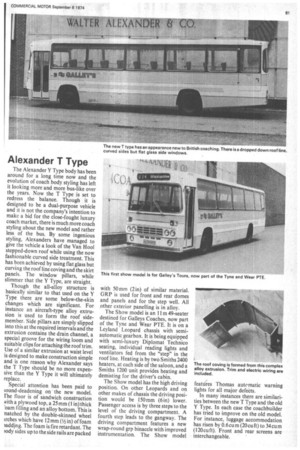Alexander T Type
Page 89

If you've noticed an error in this article please click here to report it so we can fix it.
The Alexander Y Type body has been around for a long time now and the evolution of coach body styling has left it looking more and more bus-like over the years. Now the T Type is set to redress the balance. Though it is designed to be a dual-purpose vehicle and it is not the company's intention to make a bid for the close-fought luxury coach market, there is much more coach styling about the new model and rather less of the bus. By some ingenious styling, Alexanders have managed to give the vehicle a look of the Van Hool stepped-down roof while using the now fashionable curved side treatment. This has been achieved by using flat glass but curving the roof line coving and the skirt panels. The window pillars, while slimmer that the Y Type, are straight.
Though the all-alloy structure is basically similar to that used on the Y Type there are some below-the-skin changes which are significant. For instance an aircraft-type alloy extrusion is used to form the roof sidemember. Side pillars are simply slipped into this at the required intervals and the extrusion contains the drain channel, a special groove for the wiring loom and suitable clips for attaching the roof trim. Use of a similar extrusion at waist level is designed to make construction simple and is one reason why Alexander says the T Type should be no more expensive than the Y Type it will ultimately replace.
Special attention has been paid to ;ound-deadening on the new model. The floor is of sandwich construction Nith a plywood top, a 25 mm (I in) thick 'oam filling and an alloy bottom. This is natched by the double-skinned wheel irches which have 12 mm (1/2 in) of foam 'adding. The foam is fire retardant. The 'ody sides up to the side rails are packed with 50 mm (2 in) of similar material. GRP is used for front and rear domes and panels and for the step well. All other exterior panelling is in alloy.
The Show model is an 11m 49-seater destined for Galleys Coaches, now part of the Tyne and Wear PTE. It is on a Leyland Leopard chassis with semiautomatic gearbox. It is being equipped with semi-luxury Diplomat Technic° seating, individual reading lights and ventilators fed from the "step" in the roof line. Heating is by two Smiths 2400 heaters, at each side of the saloon, and a Smiths 1200 unit provides heating and demisting for the driver's cabin.
The Show model has the high driving position. On other Leopards and on other makes of chassis the driving position would be 150 mm (6in) lower. Passenger access is by three steps to the level of the driving compartment. A fourth step leads to the gangway. The driving compartment features a new wrap-round grp binaccle with improved instrumentation. The Show model features Thomas automatic warning lights for all major defeats.
In many instances there are similarities between the new T Type and the old Y Type. In each case the coachbuilder has tried to improve on the old model. For instance, luggage accommodation has risen by 0.6 cu m (20 cu ft) to 34 cu m (120 cuft). Front and rear screens are interchangeable.


























































































































































